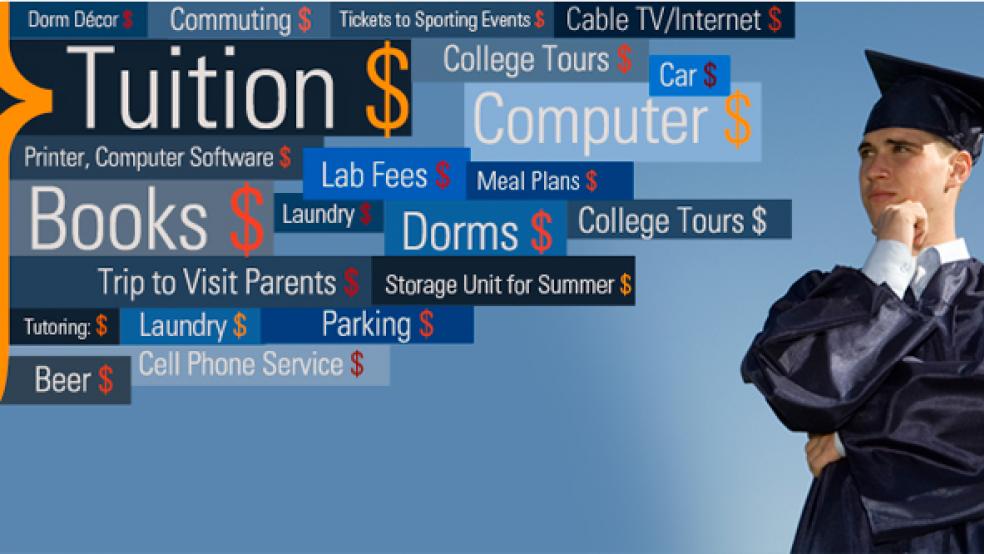Numbers don’t lie, but they can cheat. Experts say the average cost of tuition, room and board, and general fees is $16,140 for a public four-year university and $36,993 at a private school. Meanwhile, the average student debt graduates with $24,000 — if they make it through four years. Those numbers may sound big, but as any parent with a child (or two) in college can tell you, they represent only a small part of the overall tab. When you look beyond the official sticker price, the total cost of a four-year college education is much higher. Not surprisingly, many institutions also underreport their “average” student debt, or don’t report it at all.
The cost of college has tripled in the past 30 years: tuition is increasing at twice the rate of inflation, and room and board is growing 6.5 percent each year. But on top of those charges, there are thousands of dollars in costs that many families don’t calculate. “The main reason why people who go to public universities end up in debt, is not the tuition, but the living away from home expenses, which at a public university, are three or four times more than tuition,” says Andrew Hacker, co-author of Higher Education? How Colleges are Wasting Our Money And Failing Our Kids – And What We Can Do About It .
When we calculated the average costs of 20 common items, including the cost of buying a modest used car, we found that a $64,560 four-year public school education can end up costing $133,299. That’s nearly $70,000 above the advertised price. No wonder some students end up over $100,000 in debt. Here are some hidden costs parents should consider as they put together their budgets.
College tours. Can’t decide which school to attend and want to see the campus in person? A company called College Visits charges about $1,500 a person for a New England tour of 10 colleges. If only one parent goes with you, that’s $3,000 without airfare, a number that Cliff Kramon, an independent college advisor, says is common even for families doing the tour on their own.
Books. The average student pays $1,000 a year in textbooks, up 40 percent since 2000. Total cost over four years: $4,000.
Lab fees. For science majors, lab fees average about $50 a class, and more for majors like nursing. If a student takes three lab classes a semester, that’s $300 a year, or $1,200 over four years.
Tutoring. Getting extra help to prepare for that math test can range anywhere from $30/hour to $200/hour. Let’s say you pay someone in the middle range of $75/hour for about 10 hours of tutoring a semester, that’s $1,500 a year, and $6,000 over four years.
Dorm décor. TIME magazine estimated that $1 out of every $10 in back-to-school college purchases like clothes, books, stereos and computers, went to decorating the dorm. One student guessed they spent $1,500, another said $3,000. “When mom and dad went to college, all they got was an iron cot, a military mattress and mystery meat at the cafeteria,” says Hacker. “Today, it’s a whole lot more.”
Commuting. It doesn’t sound like a significant expense, but it can really add up. One student at UC Berkeley who commuted 20 miles round trip to a class three times a week in a high-millage Honda Civic, spent about $20 a month on gas, or $240 a year, which adds up to $960 over four years.
Car. The cost of that Honda Civic? $15,805 for a basic model. According to U.S. News & World Report, about 50 percent of student who live on campus have cars. And when Hacker was visiting colleges to research his book, he noted that “a bunch of the cars in the parking lot were new cars.”
Parking. It can run $500 a semester at some colleges. Total cost over four years: $4,000.
Computer. Nearly every student -- 95 percent -- owns a computer, according to research firm Student Monitor. Pricey Macs are popular among college students; 47 percent of students planned to buy a Mac last fall, according to Student Monitor. A new basic-model MacBook Air starts at $999.
Computer accessories and software. Microsoft office, Norton Antivirus, inkjet printer, Internet router…the computer is just the beginning. Basic software and accessories can set you back $275.
Storage unit for summer. A 5-foot by 5-foot unit averages about $40 to $60 a month. For four summers, that’s about $600.
Unpaid summer internship. Staying on campus during the summer for that unpaid internship will cost you three months of living expenses, adding at least $3,000 to the bill. Some campuses like New York University rent out dorms in the summer for about $1,000 a month.
Laundry. True, you’d have to do laundry even if you weren’t in college (at least we’d hope so), but it still boosts overall costs. Even $5 a week adds up: that’s $1,040 over four years.
Cell phone service. Want an iPhone to call home to mom and dad every day? Count on an initial cost of at least $200, plus $80 a month over four years adds up to be $4,040.
Cable TV/Internet. Even splitting these bills between you and your roommates, the costs add up. A cable/Internet package can cost about $150 a month, or $50 for each roommate. That’s $1,800 over four years, not including summers.
Trips to visit parents or vice versa. Don’t forget to figure in trips to see the parents. Slightly more than half (56 percent) of college freshman attended a school within 100 miles of their home, according to a 2005 UCLA survey. So let’s say 200 miles round trip, every other month, in that Honda Civic adds up to $180 a year, or $720 over four years, and that’s not including hotel costs for visiting parents.
Beer. In Academically Adrift: Limited Learning on College Campuses, the author found that in an average 168-hour week, college students spend 50 percent of their time socializing, and only 7 percent studying. For a large portion of college students, socializing means drinking. A Department of Health and Human Services study found that students spend $5.5 billion on alcohol each year. One expert estimated that students spend $50 a week on alcohol, but others put that closer to $10 a week. Even for those moderate drinkers, that’s $2,080 over four years.
Tickets to sporting events. At a big sports school, expect to attend games. At the University of Missouri, season tickets to football games cost $230, or $920 for four seasons.
Health fees. If a student can’t be added onto their parents’ health care plan, expect to pay about $1,100 per semester, or $8,800 over four years. In some cases, parents failed to fill out the waiver and paid double. There's also insurance that some schools require.
Fraternity and Sorority Dues. Even for those living out of the house, dues and fees average about $2,000 a year, or $8,000 over four years.
In addition these extra expenses that balloon the cost of college, average debt figures are most likely higher than the estimates. Experts at the Project on Student Debt, an initiative of the Institute for College Access & Success, calculate the $24,000 average student debt level number, based on data reported every four years by the Department of Education. One glitch: the data includes only student debt upon graduation, ignoring the 44 percent of students who don’t graduate within six years of enrolling. And only colleges who participate in the Federal Pell Grant program are required to report the information, leaving out some private and for-profit colleges. No college has to report private loans, which in 2008, accounted for 25 percent of total student loans. “It’s impossible to find out anything from the private lenders,” says Sandy Baum, an economist at the College Board. “Sometimes the student borrows money and the school doesn’t even know.”
The only other database for student loans is the called the Common Data Set, which is calculated by Peterson’s, the College Board and the U.S. News & World Report, but has many of the same flaws. Since it’s completely voluntary for the colleges to report information to the Common Data Set, only about 60 percent do so. Of those, many don’t report loan data, according to Mark Kantrowitz, publisher of FinAid.org and Fastweb.com. And of course, the colleges that are least likely to report are the ones with more extreme student debt levels. He estimates that the average debt is closer to $27,200, and if parent loans are included, a slice of borrowed money that many people overlook, that becomes $34,400. “My analysis suggests that the national average [for student debt] is significantly underreported,” says Kantrowitz.
Related Links:
5 Innovative and Offbeat Ways to Pay for College (The Fiscal Times)
I Want a Refund! Grads Who Would Return Their Degree (The Fiscal Times)
Rising Tuition + Student Loans = Education Bubble (The Fiscal Times)





